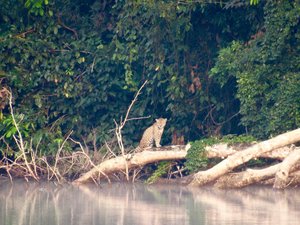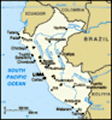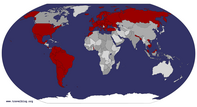Advertisement
Published: September 1st 2019

 Jaguar!
Jaguar!
This is right after it came out of the jungle to get a drink from San Salvador Lake at about 6am.Manú National Park, or Manú Biosphere Reserve, is a giant area of Peru’s Amazonian jungle. Only a small fraction of it is available to tourists, with the vast majority reserved for wildlife, native tribes and researchers who have managed to get a permit. Since UNESCO officially recognized it as a World Heritage site in 1977, the Peruvian government has been buying large areas of land that border the park. These buffer zones are open to tourists, but closed to logging and most development. The reserve itself has never been logged or developed, although the native tribes who inhabit the area still follow their traditional way of life. In the information I was given before the trip, I was surprised to see we were instructed that if we saw any of the native people, we were to leave the area immediately and notify park rangers.
Manú sounded like a truly wild place so, on the recommendation of a friend who used to be a guide there, I signed up for an 8 day tour with
www.manuadventures.com It really is as wild as it sounds. It's much more remote than I had anticipated and the variety of wildlife made me feel

 More Jaguar!
More Jaguar!
We were pretty far away, on the other side of the lake. My photos aren't super clear because it was hard to stay still on the boat and the light was low, but we didn't want to scare it off. Better to have slightly fuzzy photos than none at all.like I really was in the Amazon. I posted the species list of what I saw at the end of the blog, so as not to bore those of you who aren’t into long lists.
We started out with a long drive from Cusco up to Acjanaco at about 13,000 feet. Heading down the eastern side we immediately left the dry climate of Cusco and were in the cloud forest. At this point the asphalt ended and the rest of the road was bumpy dirt. Driving down towards the jungle we stopped several times to get out of the van to spot birds. Our first was a Golden Headed Quetzal, followed by a Blue Banded Toucanet and the famous Gallito de las Rocas. It was a very good start to a trip where we frequently saw uncommon and rare birds.
The transition from cloud forest to jungle was abrupt. I had to put away my down jacket and wished I could just wear a swimsuit at about the same time. Unfortunately, due to mosquitoes and tropical bugs, I had to wear pants and long sleeves the whole time we were in the jungle. Once we were down below

 Cat Nap
Cat Nap
It was amazing how much it moved just like a regular house cat.the cloud forest I was hot and sweaty for the next week - until we drove back up into the cloud forest again on the way back to Cusco. I already have a yellow fever shot, although there have not been any reported cases of tourists getting yellow fever or malaria in Manú - probably because we are restricted to such a small zone of the primary forest.
The first night we stayed at a lodge near the road, with just a short hike into the jungle. It was beautiful and secluded with lots of tanagers during the day and fireflies at night. We left early in the morning and by noon had reached the end of the road - from here on we traveled by boat.
The second night was our first at a lodge only accessible by boat. There were lots of Weddell's Saddle-backed Tamarinds around when we first got to the lodge, but it got dark quickly so we didn't see much more wildlife. At night we got to see lots of insects and frogs though. During the night it started raining and didn’t stop until around noon the next day. The rain ruined our

 Watching Us
Watching Us
With the binoculars and telescope we could see that even when it appeared to be napping, the jaguar was always watching us.chance to zipline through the canopy, which is normally what people get to do at this second lodge, but at least I got to sleep in a bit.
Getting back on the boat in the morning everything was wet. I was a little disappointed that the rain would make it harder to see wildlife, but the guide explained that we were still in an area of secondary forest and that the next day (our fourth day of travel) we would finally get to the reserve and the primary forest. The area is so remote that it takes four full days of travel from Cusco to even get there.
Day four we finally entered the primary forest. We again got up early and were on the boat before 7am, which was early enough to see hundreds of blue headed parrots, yellow crowned parrots and orange cheeked parrots eating clay from the river bank. The clay allows them to eat wild fruits which otherwise would have too many toxins or caustic chemicals for them to digest. It was beautiful and loud.
This day we left the part of the river with rocky banks and entered an area with sandy

 Red Howler Monkey
Red Howler Monkey
We saw several on the river bank, eating clay just like the parrots. Presumably also to absorb toxins so they can eat fruits they wouldn't be able to digest otherwise.beaches along both sides of the river. The best thing about the sandy banks was that we were finally to an area with caiman. I didn’t even try to count how many black and spectacled caiman we saw. Black caiman are usually 7 to 14 feet long, although older males can grow to 16 feet. There are a lot of reasons why swimming in lakes and rivers of the reserve is forbidden, but I imagine that caiman are pretty high on the list. Spectacled caiman are smaller, but their jaws are just as strong, teeth just as sharp and tail just as powerful as the larger black caiman.
That night, at the fourth lodge, we were finally far enough into the jungle to spend two nights at the same place. There were lakes to explore, trails through the jungle and so much more wildlife to see even from the river banks. Our first morning (which was the fifth day of the trip) we set out in a boat to see if we could find the famous and endangered giant otters. The population of giant otters is still decreasing, despite efforts to preserve the habitat it still has left. For

 Scratching
Scratching
All monkeys are funny when they use their feet to scratch their heads.the first time we were in a wide, flat boat that was paddled by our boat captain and his helper. All of our river travel was in a long motor boat, so it was a relief to be on a quiet boat.
The lake was a circular abandoned meander of the Madre de Dios river, named Salvador Lake. We got up at 4:30 so we could be on the boat before 6am. After half an hour of paddling quietly down one half of the lake, without seeing any otters, we turned around to go back and see if we would have any luck on the other half. Just a few minutes after turning around we saw what every tourist hopes to see in the jungle: a jaguar.
The sun was just rising and the jaguar came out of the jungle, walked down a large fallen tree trunk to the water and drank from the lake for a few minutes. We weren’t very close to the jaguar and didn’t dare paddle any closer. We watched the jaguar walk back up the trunk to a flat spot in the sun and lay down to soak up the morning rays. It

 Toppings Titi Monkey
Toppings Titi Monkey
These guys were hilarious and so, so fast. All my photos of their faces are blurry.was so magical! We watched it for about an hour, taking pictures and looking through binoculars and the guide’s telescope. Even from our distance, we could tell that the jaguar was massive. And yet, it moved just like a house cat. It lapped water from the lake just like a cat. It stretched out in the sun just like a cat. It laid its head on its paws and watched us just like a cat.
Eventually we had to tear ourselves away and paddle back to the boat launch because guides have to sign up for two hour slots on the lake, since there is only one boat. You wouldn’t want more than one group on the lake at a time anyway, since people have a tendency to scare away wildlife, no matter how quiet we are. We told the next group where we had seen the jaguar, but heard later that by the time they got there it had disappeared into the jungle again.
The next day we had to leave. I had thought that an eight day trip would give me plenty of time in the jungle, but considering that it took three full days to

 Black Spider Monkey
Black Spider Monkey
I loved how these guys used their tales to hang on to the branches even more than their hands.even get to the reserve, even an eight day trip only gives you one full day in the jungle, with only two nights at the final lodge. Day six we had to begin the long trip back to Cusco.
We got up at 4:30 again and had a long day on the river, trying to stay under the boat’s cover to keep from getting too sunburned. Sunscreen and hats can only do so much.
Our reward that night was the most beautiful hot springs I have ever seen. I’ve been to a lot of hot springs up in the mountains of Idaho, some of which are truly primitive and require a long hike or a couple days by river to access. The aguas termales de Comunidad Nativa Shintuya were just that beautiful. They have been developed just enough to have a large pool, but to still feel truly wild. Since we were camping by the springs we were able to enjoy a long soak far into the night - despite knowing that we had to get up at 4:30 again the next day to get back on the river.
This was my first time in South America’s

 Large-Headed Capuchin Monkey
Large-Headed Capuchin Monkey
Of the two capuchin species we saw, these were the most adventurous in leaving the tree tops.jungle; all my other trips in Peru have been in the mountains. I do love the Andes, but now that I’ve seen the wildlife present in the jungle, I feel very differently about the eastern side of Peru. The Amazon is under attack in so many places, mostly due to logging and people clearing the forest for cattle grazing. At least this Peruvian part of the Amazon is preserved. See a map of Manu here
http://www.manuadventures.com/manu_8_days.html The whole trip was amazing, but the hour we spent watching that jaguar was truly magical. I will definitely have to find another part of the Amazon that has been preserved enough to visit.
This blog is also available on www.heatherjasper.com
And now, the list. (I tried to not repeat species that were recorded on previous days).
Day 1: Cusco to cloud forest, evening jungle
Golden Headed Quetzal
Blue Banded Toucanet
Dusky Green Oropendola
Cinnamon Flycatcher
Tschudi’s Wooly Monkey
Gallito de las Rocas
Masked Yellowthroat
Blue Capped Tanager
Golden Naped Tanager
Beryl Spangled Tanager
Saffron Crowned tanager
Slate Throat White Start
Deep Blue Flower Piercer
Masked

 Black Caiman
Black Caiman
You can't really see the black color because of the way the sunlight was reflecting off it, but this is a really big black caiman.Trogon juv.
Andean Guan (wild turkey)
Crimson Bellied Woodpecker
Tropical Parula
Speckled Faced Parrot
Fireflies
Stick bug
Day 2: jungle from San Pedro lodge to Erika lodge
Wire Crested Thorntail (hummingbird)
Golden Olive Woodpecker
Plumbeous Kite
Amazon Dwarf Squirrel
Silver Beaked Tanager
Little Cuckoo
Stripe Chested Antwren
Squirrel Cuckoo
Masked Tanager
Blue Necked Tanager
Mottled Chick Tyrannulet
Yellow Throated Bush Tanager
Amazonian Umbrella Bird fem.
Amazonian umbrella tree
Bolivian Sunset flower
Wild ginger
Tropical King Bird
Blue Dacnis
Paradise Tanager
Orange Eared Tanager
Blue Necked Tanager
Flame Faced Tanager
Golden Tanager
Versicolored Barbet
Begonia vetgiana
Pink Begonia (invasive)
Magpie Tanager
Yellow Asters
Platanillo flower
Purple morning glory
Blue Tailed Emerald (hummingbird)
Hooded Siskin
(En zona urbana Chontachana)
Lantana flower
Black bumblebees
Red Throated Caracara
Long Tailed Tyrant
Turkey vultures
Tropical Kingbird
Blue Morpho butterfly
(On river and at camp)
Caciques with hanging nests
Oropendula with hanging nests
Cormorants

 Spectacled Caiman
Spectacled Caiman
This is a smaller species than the Black Caiman, but still not something you want to see if you're swimming. They're probably one of the reasons that swimming is forbidden in the park.Snowy egrets
Invasive cucarda
Native verbena
Scarlet Macaw
Weddell’s Saddleback Tamarind
Walking Root tree (Palm)
Leaf Cutter ants
Aguaje coconut trees (fruits for macaw)
Hoatzin (bird that eat leaves, ruminants, juv. have claws on wings)
Social Flycatcher
Horned Screamer
Rufescent Tiger Heron
Chestnut Eared Aracari (Toucan)
Blue Gray Tanager
Black Capped Donacobius
Spangled Cotinga
Fasciated Tiger Heron
Sand Colored Nighthawk
Day 3: Erika lodge to Boca Manu
Tiny Hawk
Great Black Hawk
Yellow Billed Tern
Large Billed Tern
Plumbius Dove
Swallowtail Kite
Double-toothed Kite
Plumbeous Kite
Scarlet Macaw
Chestnut Macaw
Green and Red Macaw
Vermillion Flycatcher
White Winged Swallow
White Banded Swallow
Southern Rough Wing Swallow
Cocoi Heron
Fasciated Tiger Heron
Little Blue Heron
Great Egret
Snowy Egret
Giant Cowbird
Shiny Cowbird
King Vulture
Black Vultures
Turkey Vultures
Tropical Kingbird
Neotropic Cormorant
Russet Backed Oropendula
Day 4: Boca Manu to Sajino lodge in primary jungle
Blue Headed Parrots
Yellow Crowned Parrots

 Swimming v. Walking
Swimming v. Walking
We saw lots of caiman swim very quickly across the river, or disappear suddenly into the muddy water. They looked powerful and threatening, but when they walk on land they just look silly.Orange Cheeked Parrots
Anhinga
Black Caiman
Spectacled Caiman
Red Howler Monkey
Bolivian Black Capped Squirrel Monkey
Toppings Titi Monkey
Large Headed Capuchin Monkey
Black Spider Monkey
Solitary Sandpiper
Spotted Sandpiper
Gray Tinamou
Swallowtailed Kite
Red Capped Cardinal
Collared Plover
Spot Breasted Woodpecker
White Throated Toucan
Pied Lapwing
Orinoco Goose
Muscovy Duck
Sand Bittern
Yellow Headed Vulture
Wattle Jacana
Laughing Falcon
Capped Heron
Amazon Kingfisher
Ringed Kingfisher
Black Skimmer
Pale-eyed Blackbird
Swallow winged Blackbird
Swallow winged Puffbird
Podocnemis unifilis (Tarikaya River Turtles: endangered)
Amarakaeri Big Headed Frogs
Purple Scorpion
Pristimantis Frog
Cusco Rubber Frog
Velvet spiders (X shaped web)
Cotton Tree
Bullet Ants
Army Ants
Day 5: in Biosphere Reserve
Striated Heron
Gray-necked Wood Rail
Limpkin
Sand bittern
Cocoi heron
Purple gallinule
JAGUAR!!!!!!!!!!!!
Least Grebe
White Fronted Capuchin Monkey
Green Kingfisher
Screaming Piha
Collared Trogon: male and female
Southern Tamandua (Anteater)
Strangler Tree
Sigueme sigueme

 Golden Headed Quetzal
Golden Headed Quetzal
This isn't a very good picture since it didn't want to turn around for a real portrait, but it was still a very good omen for the uncommon and rare birds that we saw over the next few days.(Vine)
Wikungo (spike palm)
Large Headed Capuchin
Sacha Papaya tree
Little Tinamou
Tschudi Woolly Monkey
White Fronted Capuchin (introduced)
Large Head Capuchin
Black Spider Monkey
Ornate Hawk-Eagle
Masked opossum
Oxyrhopus (fake coral snake)
Fer de lance snake
Day 6: leaving the jungle (Lots of birds already listed on other days)
Wood Stork
King Vulture
Capybara
Days 7-8: species already listed
There are lots more photos below, so scroll down.
Advertisement
Tot: 0.083s; Tpl: 0.018s; cc: 14; qc: 22; dbt: 0.0325s; 1; m:domysql w:travelblog (10.17.0.13); sld: 1;
; mem: 1.1mb



































Béné
non-member comment
Souvenirs...
Ton récit me rappelle notre voyage en Bolivie : jaguar, caïman... Tu sais que tu pourrais aussi te convertir en photographe animalier !!! Bisous